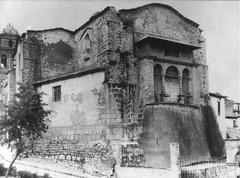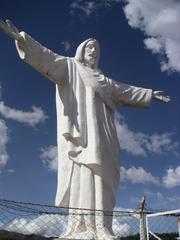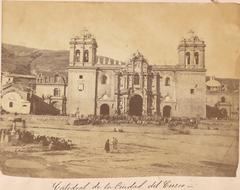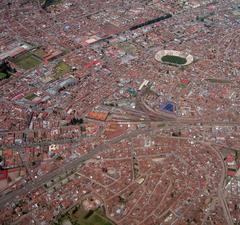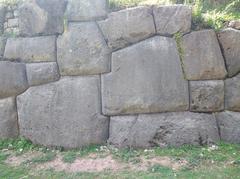Puka Pukara: Visiting Hours, Tickets, and Historical Sites in Cusco, Peru
Date: 14/06/2025
Introduction
Just 7 kilometers northeast of Cusco lies Puka Pukara—meaning “Red Fortress” in Quechua—an enduring symbol of the Inca Empire’s military prowess and architectural ingenuity. Constructed in the 15th century at the empire’s height, Puka Pukara served as a strategic fortress, checkpoint, and administrative center along the vital Qhapaq Ñan road network. Its name comes from the reddish stones that glow at sunset, providing a stunning visual experience (Cooltura Peru).
Strategically perched on a hillside, Puka Pukara offered commanding views to monitor the movement of travelers and goods entering Cusco. The site’s robust walls, terraces, plazas, and lodging facilities reflect a sophisticated blend of defense, administration, and hospitality, serving soldiers, messengers, dignitaries, and royalty en route to sacred sites like Tambomachay. Today, Puka Pukara remains a key stop for those wishing to explore Cusco’s rich cultural heritage, easily accessed by taxi, local bus, or as part of guided tours and included in the Cusco Tourist Ticket (CuscoPeru.com).
This guide provides comprehensive information on Puka Pukara’s history, architecture, visiting hours, ticketing, travel tips, and nearby attractions. Whether you’re a history enthusiast or a curious traveler, prepare to immerse yourself in the enduring legacy of the Inca Empire (Peru Grand Travel; Journey Machu Picchu).
Table of Contents
- Origins and Construction of Puka Pukara
- Military and Administrative Functions
- Relationship with Nearby Sites
- Architectural Features and Symbolism
- Cultural and Historical Significance
- Inca Defense Context
- Visitor Information (Hours, Tickets, Accessibility)
- Travel Tips
- Special Events, Tours, and Photography
- Nearby Attractions
- Frequently Asked Questions (FAQ)
- Visuals and Interactive Elements
- Further Reading and References
Origins and Construction of Puka Pukara
Puka Pukara is an archaeological site situated about 7 kilometers (4.3 miles) northeast of Cusco, Peru. Its name—“Red Fortress”—comes from the reddish hue of its stones, particularly vivid at sunset (Cooltura Peru). Built in the 15th century, it was a crucial outpost on the Qhapaq Ñan, the main Inca road connecting Cusco with other regions.
The fortress features robust stone walls, terraces, stairways, and plazas. Construction reflects classic Inca masonry: large, irregular stones precisely fitted without mortar. Its hilltop position provided strategic surveillance over the valleys and trails leading to Cusco.
Military and Administrative Functions
Puka Pukara’s primary purpose was to serve as a military outpost and checkpoint. Its strategic location allowed the Incas to monitor and control access to the empire’s capital (Cooltura Peru). As an early warning post, it alerted defenders at Sacsayhuamán and other sites of approaching threats.
Additionally, Puka Pukara functioned as an administrative hub. Plazas and terraces facilitated the management of travelers, messengers, and goods. Lodging facilities provided accommodations for royalty, military leaders, and dignitaries heading to Cusco or ceremonial sites like Tambomachay.
Relationship with Nearby Sites
Puka Pukara’s significance is tied to its proximity to sites like Tambomachay—a ceremonial water temple. While Tambomachay focused on ritual and water management, Puka Pukara played a protective role. The two sites are often visited together, exemplifying the Inca integration of military, administrative, and religious functions (Cooltura Peru). Puka Pukara was also part of a larger defensive network that included Sacsayhuamán, forming a sophisticated multilayered defense system for Cusco.
Architectural Features and Symbolism
The fortress is ingeniously adapted to the hillside, with three main levels:
- First Level: The outer defensive wall and adjacent rooms, likely used for storage or lodging.
- Second Level: A secondary wall, broad platforms (possibly parade grounds), and terraced gardens.
- Third Level: The highest point, offering panoramic views for surveillance.
Architectural highlights include concentric defensive walls, trapezoidal rooms and doorways (classic Inca earthquake-resistant design), open plazas, aqueducts, and remnants of water channels—showcasing advanced Inca water management. The reddish stones were both practical and symbolic, representing power and protection in Inca culture (Cooltura Peru).
Cultural and Historical Significance
Puka Pukara stands as a testament to the Incas’ ability to blend military, administrative, and ceremonial functions. Its integration into the Qhapaq Ñan allowed rapid movement of armies, messengers (chasquis), and goods—crucial for controlling the vast empire. The fortress also reflects the Inca respect for nature, skillfully harnessing the landscape’s advantages for defense and visibility.
Puka Pukara in the Context of Inca Defense
The defensive system around Cusco was among the most advanced in pre-Columbian South America. As an early warning post, Puka Pukara was crucial for alerting the main garrison at Sacsayhuamán of approaching threats (Cooltura Peru). Its thick walls and elevated terraces provided security for both soldiers and travelers, illustrating the dual military and hospitality functions typical of Inca sites.
Visitor Information: Hours, Tickets, and Accessibility
Visiting Hours
- Open daily: 7:00 am to 6:00 pm (Terandes; Peru Grand Travel)
Tickets and Entrance
- Entry included in the Cusco Tourist Ticket (Boleto Turístico del Cusco, BTC):
- Integral Ticket: 130 soles (foreigners), valid for 10 consecutive days. Covers 16 sites including Puka Pukara, Sacsayhuamán, Tambomachay, and more (CuscoPeru.com; Terandes).
- Partial Tickets: Not valid for Puka Pukara unless specified for the Sacsayhuamán circuit.
- Where to Buy: Online via official website (Spanish), at ticket offices in Cusco, or included in tour packages.
- Requirements: Passport or national ID required for entry.
Accessibility
- Terrain is uneven with stone steps; not wheelchair accessible.
- Comfortable walking shoes recommended.
- Basic restroom facilities at the entrance; limited on-site services (Journey Machu Picchu).
Travel Tips
- Acclimatize: The altitude (3,580–3,850 meters) can cause sickness. Spend 1–2 days in Cusco before visiting (Journey Machu Picchu).
- Best Time: Early morning or late afternoon to avoid crowds and capture the red stones at their most vivid.
- Essentials: Bring water, sun protection, a camera, and a light jacket.
- Respect: Stay on marked paths and avoid climbing on ruins.
Special Events, Tours, and Photography
- Guided Tours: Highly recommended for historical context; available at the site or through tour operators (Cusco Open Tour; Veronika’s Adventure).
- Photography: Spectacular views, especially at sunset.
- Special Events: Occasional cultural reenactments or festivals—check local calendars.
Nearby Attractions
- Tambomachay: Ceremonial water temple with aqueducts and fountains.
- Qenqo: Ceremonial site with carved stones and labyrinthine passages.
- Sacsayhuamán: Major Inca fortress and UNESCO site.
- Pisac: Extensive terraces and ceremonial center in the Sacred Valley.
- Qorikancha (Temple of the Sun): Key Inca religious site in Cusco city.
Frequently Asked Questions (FAQ)
Q: What are Puka Pukara’s visiting hours?
A: Open daily from 7:00 am to 6:00 pm.
Q: How do I buy tickets?
A: Through the Cusco Tourist Ticket, available online, at ticket offices, or with tours.
Q: Is Puka Pukara accessible for visitors with mobility issues?
A: The site has uneven terrain and stone steps; accessibility is limited.
Q: Are guided tours available?
A: Yes, many local agencies offer tours including Puka Pukara and nearby sites.
Q: How do I get there?
A: By taxi (20–30 minutes from Cusco; 20–30 soles), public bus/colectivo (1–6 soles), or on foot (1.5–2 hours hike) (Jetset Jansen; Tierras Vivas).
Visuals and Interactive Elements
 Alt text: Puka Pukara fortress walls glowing red during sunset with mountainous backdrop.
Alt text: Puka Pukara fortress walls glowing red during sunset with mountainous backdrop.
Interactive Map of Puka Pukara and Nearby Sites
Summary Table: Key Nearby Attractions
| Site | Distance from Cusco | Notable Features | Typical Visit Duration |
|---|---|---|---|
| Puka Pukara | 7 km | Inca fortress, panoramic views | 30–45 min |
| Tambomachay | 8 km | Ceremonial baths, aqueducts | 30 min |
| Q’enqo | 4 km | Labyrinthine ruins, ceremonial altars | 30–45 min |
| Sacsayhuamán | 2 km | Massive stone walls, festival site | 1–2 hrs |
| Pisac | 33 km | Terraces, ceremonial center, market | 2–3 hrs |
Conclusion
Puka Pukara offers a unique blend of military history, architectural ingenuity, and breathtaking natural scenery. Its multifaceted role as a fortress, checkpoint, and administrative hub highlights the Incas’ sophisticated approach to defense and governance. With convenient visiting hours and inclusive ticketing, it is an essential stop for anyone exploring Cusco’s rich heritage. Plan your visit to experience the “Red Fortress” and gain insight into the world of the Incas.
For up-to-date information, guided audio tours, and offline maps, download the Audiala app. Stay informed about special events and travel tips by following us on social media. Start your adventure and immerse yourself in one of Peru’s most remarkable archaeological sites!
References and Further Reading
- Puka Pukara: Discovering the Inca Fortress of Red Stones (Cooltura Peru)
- Visiting Puka Pukara: Hours, Tickets, and Tips (Peru Grand Travel)
- The Puka Pukara Ruins in Peru (Journey Machu Picchu)
- Cusco Touristic Ticket Information (CuscoPeru.com)
- Puka Pukara, Archaeological Sites in Cusco (Terandes)
